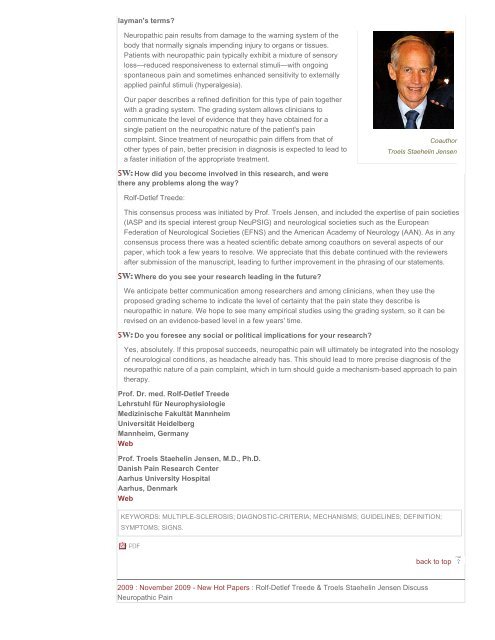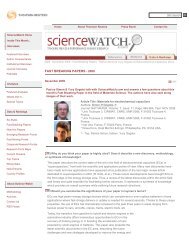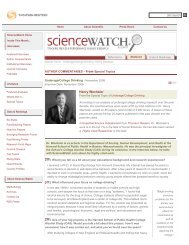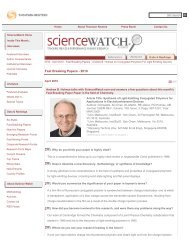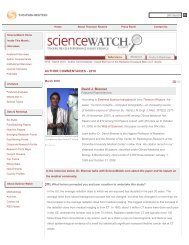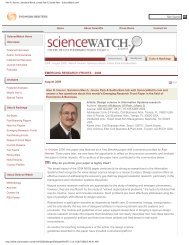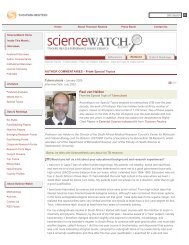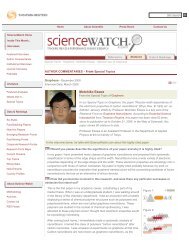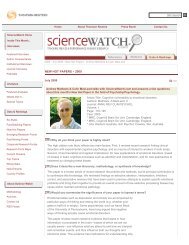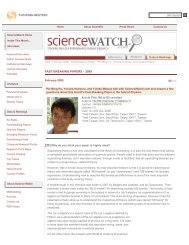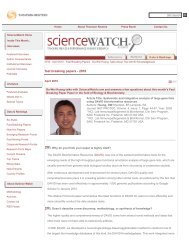Rolf-Detlef Treede & Troels Staehelin Jensen Discuss Neuropathic ...
Rolf-Detlef Treede & Troels Staehelin Jensen Discuss Neuropathic ...
Rolf-Detlef Treede & Troels Staehelin Jensen Discuss Neuropathic ...
Create successful ePaper yourself
Turn your PDF publications into a flip-book with our unique Google optimized e-Paper software.
layman's terms<br />
<strong>Neuropathic</strong> pain results from damage to the warning system of the<br />
body that normally signals impending injury to organs or tissues.<br />
Patients with neuropathic pain typically exhibit a mixture of sensory<br />
loss—reduced responsiveness to external stimuli—with ongoing<br />
spontaneous pain and sometimes enhanced sensitivity to externally<br />
applied painful stimuli (hyperalgesia).<br />
Our paper describes a refined definition for this type of pain together<br />
with a grading system. The grading system allows clinicians to<br />
communicate the level of evidence that they have obtained for a<br />
single patient on the neuropathic nature of the patient's pain<br />
complaint. Since treatment of neuropathic pain differs from that of<br />
other types of pain, better precision in diagnosis is expected to lead to<br />
a faster initiation of the appropriate treatment.<br />
Coauthor<br />
<strong>Troels</strong> <strong>Staehelin</strong> <strong>Jensen</strong><br />
How did you become involved in this research, and were<br />
there any problems along the way<br />
<strong>Rolf</strong>-<strong>Detlef</strong> <strong>Treede</strong>:<br />
This consensus process was initiated by Prof. <strong>Troels</strong> <strong>Jensen</strong>, and included the expertise of pain societies<br />
(IASP and its special interest group NeuPSIG) and neurological societies such as the European<br />
Federation of Neurological Societies (EFNS) and the American Academy of Neurology (AAN). As in any<br />
consensus process there was a heated scientific debate among coauthors on several aspects of our<br />
paper, which took a few years to resolve. We appreciate that this debate continued with the reviewers<br />
after submission of the manuscript, leading to further improvement in the phrasing of our statements.<br />
Where do you see your research leading in the future<br />
We anticipate better communication among researchers and among clinicians, when they use the<br />
proposed grading scheme to indicate the level of certainty that the pain state they describe is<br />
neuropathic in nature. We hope to see many empirical studies using the grading system, so it can be<br />
revised on an evidence-based level in a few years' time.<br />
Do you foresee any social or political implications for your research<br />
Yes, absolutely. If this proposal succeeds, neuropathic pain will ultimately be integrated into the nosology<br />
of neurological conditions, as headache already has. This should lead to more precise diagnosis of the<br />
neuropathic nature of a pain complaint, which in turn should guide a mechanism-based approach to pain<br />
therapy.<br />
Prof. Dr. med. <strong>Rolf</strong>-<strong>Detlef</strong> <strong>Treede</strong><br />
Lehrstuhl für Neurophysiologie<br />
Medizinische Fakultät Mannheim<br />
Universität Heidelberg<br />
Mannheim, Germany<br />
Web<br />
Prof. <strong>Troels</strong> <strong>Staehelin</strong> <strong>Jensen</strong>, M.D., Ph.D.<br />
Danish Pain Research Center<br />
Aarhus University Hospital<br />
Aarhus, Denmark<br />
Web<br />
KEYWORDS: MULTIPLE-SCLEROSIS; DIAGNOSTIC-CRITERIA; MECHANISMS; GUIDELINES; DEFINITION;<br />
SYMPTOMS; SIGNS.<br />
back to top<br />
2009 : November 2009 - New Hot Papers : <strong>Rolf</strong>-<strong>Detlef</strong> <strong>Treede</strong> & <strong>Troels</strong> <strong>Staehelin</strong> <strong>Jensen</strong> <strong>Discuss</strong><br />
<strong>Neuropathic</strong> Pain


